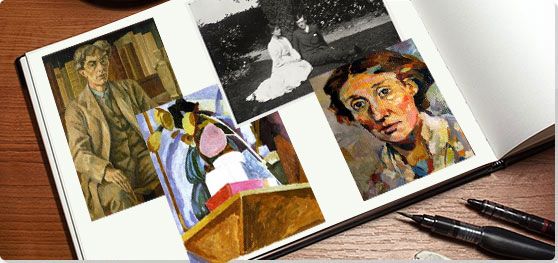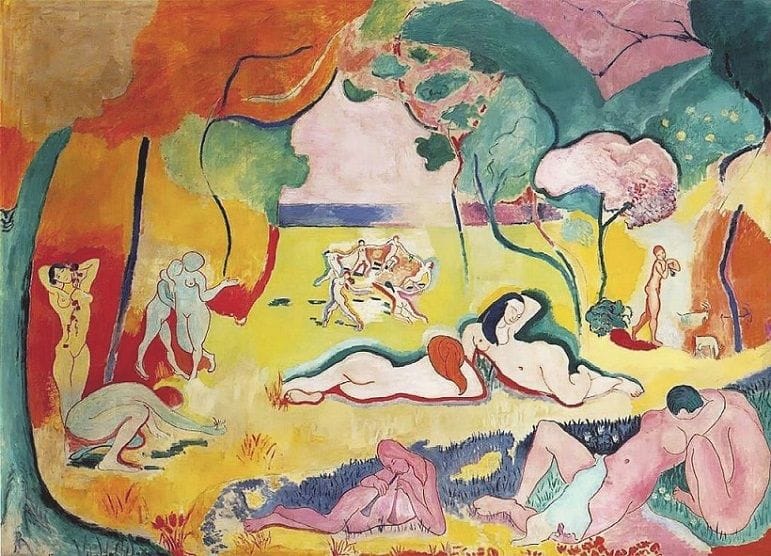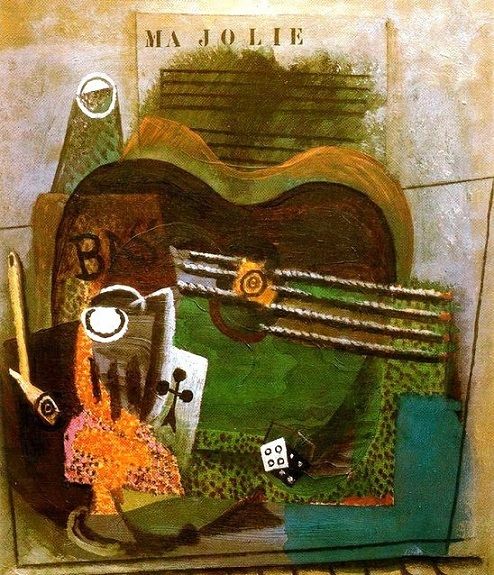Summary of The Bloomsbury Artists
The Bloomsbury artists were a group of innovative British artists, designers, and art critics who breathed fresh life into the UK's stuffy art scene in the first half of the 20th century. The group's members contributed significantly to 20th-century British art and design by working on a huge range of individual and collaborative projects, from cushion covers and candlesticks to abstract paintings and multiple murals. They are also credited with introducing important European artists such as Picasso and Cézanne to a UK audience.
The Bloomsbury artists as we refer to them here were the original, artistic arm of the Bloomsbury Group, a broader set of London-based creatives and intellectuals that included novelists Virginia Woolf and E. M Forster, economist John Maynard Keynes and writer Lytton Strachey among its most prominent members. Whether through painting, novel writing or philosophy, all members of 'old Bloomsbury' shared a passion for social progress, creative innovation and a desire to leave behind the restrictive atmosphere of the Victorian era.
Key Ideas & Accomplishments
- The group's artistic output was highly influenced by art critic and fellow Bloomsbury member Clive Bell's theory of 'significant form'. Bell believed that forms and relations of forms within an artwork combine to "stir our aesthetic emotions", even when entirely isolated from a discernible reality.
- Unsurprisingly for a group whose personal lives were so infamously intertwined, the three principal Bloomsbury artists - Vanessa Bell, Duncan Grant, and Roger Fry - often worked in remarkably close proximity to each other. They regularly painted the same subjects at the same time (mainly interiors, scenes from their joint travels to Europe, still lifes, and portraits of other group members) though their styles remained reasonably distinctive.
- The Bloomsbury artists were strongly influenced by and responsive to the European movements of their day, especially Post-Impressionism (a term coined by Roger Fry) and Cubism. Their previously conservative artistic styles changed dramatically after they viewed works by Picasso, Matisse, and Cézanne during a 1909 visit to Paris. The group is now widely recognized as important British 'champions of modernity' for being the first to include these controversial European artists in London exhibitions, much to the shock of UK gallery goers.
- Collaboration and cross-promotion were fundamental to the Bloomsbury ethos. As well as working with each other on murals, interiors, stage designs, and costumes, the group's visual artists produced book jacket covers and illustrations to accompany publications by Bloomsbury writers and their modernist associates, including works by Virginia Woolf, T.S Eliot, and some of the first English translations of Sigmund Freud.
- The entire Bloomsbury group's attitudes toward gender roles and sexuality were extraordinarily progressive, especially by the standards of their day in Britain. These attitudes often translated to the group's artistic output - they produced some of the earliest works to now be considered essential to the Queer art canon, for example. Virginia Woolf's seminal essays, such as A Room of One's Own, also had a vital impact on the development of feminism (including Feminist art) in the 20th century and beyond.
Artworks and Artists of The Bloomsbury Artists
The Borough Polytechnic Murals
This series of murals, commissioned and installed in London's Borough Polytechnic's canteen, is a key example of the Bloomsburys' collaborative philosophy in practice. Lively and startlingly modern for the time, the figures in the various panels are depicted participating in what were decidedly contemporary recreational activities, such as swimming in London's Serpentine Lake and playing football in the city's Hyde Park.
The project was devised and led by Roger Fry, though he was loose in his approach to leading it. He relied on the murals' theme, 'London on Holiday', a shared palette and an understanding that all the artists would paint outlines using a style inspired by Byzantine mosaic to give individual sections a coherent feel. The project's significance lay in its democratic subject matter and setting - it's now seen as a key work in the history of Public art, realized as it was at low cost and in a college refectory rather than a grand museum or gallery.
The murals were generally very well received by the press and public, though there were some complaints that their subject matter could prove a corrupting influence on the college's students. The London Evening Standard newspaper's art critic called them 'the most important artistic event of 1911', while London's Times newspaper praised it too, encouraging readers to accept and delight in its radical, Post-Impressionist approach: 'Do not ask yourself, as you look at it, whether it is at all like the Serpentine or any bathers in it that you have ever seen,' they wrote. 'It is not, and is not meant to be. But, if you will not demand any illusion, you will find that it gives you an extraordinarily keen sense of the pleasure of swimming. In fact it acts on you like poetry or music.'
The project was run on a tight budget of £100, meaning the murals were painted in oil onto canvas panels instead of directly on the walls - a decision that ultimately led to their preservation when the Polytechnic's building changed ownership in the 1930s.
Oil on canvas - Collection of the Tate, United Kingdom
Candleshade Designs For The Omega Workshops
This design for a set of candle shades was one of the earliest produced for the Omega Workshops - the collaborative, Bloomsbury-led decorative art initiative conceived by Roger Fry in 1913. Featuring radical, highly pared down forms and bold colors that reflect the techniques and ideas of the Post-Impressionists, these designs are archetypally Omega. In contrast with previous, comparable schemes that blurred the boundary between art and design - most famously William Morris's Arts and Crafts movement of the late-19th century - Fry was determined that Omega artworks focus purely on aesthetic merit, rather than aiming to make political or social points.
A prolific painter, novelist, and critic, Wyndham Lewis was a key - though brief - early associate of the Bloomsbury Group. He exhibited three oil paintings at Fry's second Post-Impressionist exhibition of 1912 and produced several popular designs for Omega, but had a dramatic and high profile falling out with Fry and Clive Bell in 1913. He went on to found rival decorative workshop, the Rebel Art Centre, and the short lived but highly influential Vorticist movement, considered the first truly avant-garde art movement in the UK. The Vorticists explicitly rebelled against what they saw as the horribly bourgeois Bloomsbury artists in particular - Lewis sneeringly described them as 'Fitzroy tinkers'. He reserved particular wrath for Fry (who he called a 'shabby trickster' and 'hypocrite') and Virginia Woolf (a 'peeper' into other people's affairs.) This feud with the whole Bloomsbury Group would ultimately last for decades - in 1930, Lewis expressed his continuing disdain for London's literary and artistic set in a biting satirical novel, The Apes of God.
Collection of the Tate, United Kingdom
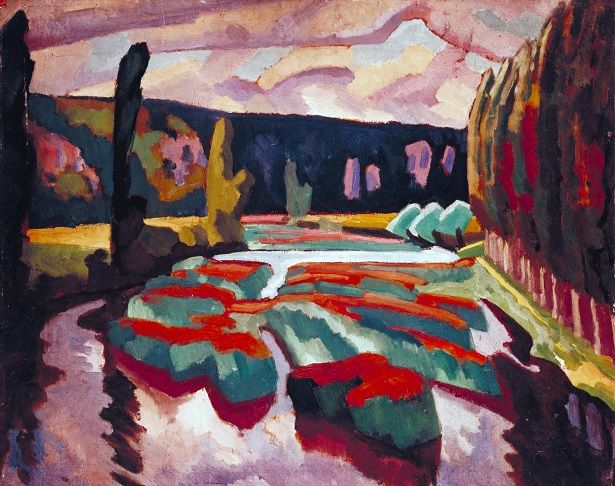
River With Poplars
In River With Poplars, Roger Fry painted the view from a bridge in the village of Angles sur l'Anglin at Poitiers, France, using bold, uniformly solid blocks of color to represent every element of the scene, including the water and cloudy sky. Fry had been inspired by the work of iconic Post-Impressionist Paul Cézanne when creating the piece, though the birth of his interest in the French painter sadly coincided with Cézanne's death in 1906.
By the time River With Poplars was completed in 1912, Fry had been working according to his own aesthetic theory based on Cézanne's methodology for several years - using careful brushstrokes to 'construct' an image rather than simply 'paint' it. His theory of significant form, which was enthusiastically embraced by the other Bloomsbury artists, also stressed the importance of form (by which he meant a congenial combination of line, color and overall composition) in invoking what he called 'an emotional response' in the viewer - an idea that's richly demonstrated here.
From a contemporary perspective, Fry's individual artworks hold more symbolic than artistic significance. He's generally acknowledged as a weaker artist than, say, Vanessa Bell, whose abstract paintings from the same period are now widely considered revolutionary. His most important contributions to the Bloomsbury Group were as a theorist and curator (he was curator of European painting at MOMA in New York between 1906 - 10), but his experiments with Post-Impressionist techniques were crucial demonstrations of his seminal theories brought to artistic life.
Oil paint on wood - Collection of the Tate, United Kingdom
The Big Girl
This aggressively expressive portrait by early Bloomsbury member Frederick Etchells is actually not a portrait of an individual woman, but a combination of the artist's sister, Jessie Etchells, and Madge Pulsford, a friend of the group. Etchells wanted to focus on form, line, and mood rather than making a traditional portrait of a single sitter. The strong outlines of the figure, chair, and cushions are all awkward and intentionally crudely painted, while the entire painting is filled with heavy, Pointillist-style dots.
A trained architect as well as an artist, Etchells was friends with such European luminaries as Braque, Picasso, and Modigliani, and The Big Girl certainly feels influenced by these European painters' work. Its palette of soft pastels, for example, is typically Fauvist, while his stylized depiction of his subject is reminiscent of Modigliani as well as bearing a strong resemblance to the work of fellow Bloomsbury, Duncan Grant. Etchells was distinctive among the Bloomsberries for his unabashedly eccentric, even anarchic sensibility. Also a member of the Omega Works, he joined the rebellious and militant Vorticist movement soon after he completed this work, after eventually tiring of what he saw as the overly genteel Bloomsbury ethos.
Tempera on board - Collection of the Tate, United Kingdom
Abstract Kinetic Collage Painting With Sound
Abstract Kinetic Collage Painting with Sound showcases Duncan Grant's practice at its most outlandishly experimental. The 15 foot long painting is composed of 17 different images of various painted and pastel rectangles. It was originally intended to be gradually wound between two spools in a box, like a length of film, and viewed through an aperture to the sound of a piece of slow music by J.S Bach. Having given up attempting to make a suitable box and mechanism for displaying the piece at the time, Grant kept the painting in storage till he was able to show it as he'd envisaged - alongside a film commissioned by the Tate Gallery in 1974 that showed the (by then fragile) painting as close to 'kinetically' as possible.
With its pioneering exploration of movement and multisensory experience and attempt to push painting as a medium into fresh, filmic territory, this piece is now considered a key work in the history of abstraction. Grant himself is generally regarded as one of the most gifted and consistently adventurous of the Bloomsbury artists, alongside his long term lover, Vanessa Bell. Tellingly, Grant and Bell were the only artists from the group to feature works in New York's Museum of Modern Art's global survey Inventing Abstraction in 2013, with critics singling this piece out for particular praise.
Gouache, watercolor, and collage on mounted paper - Collection of the Tate, United Kingdom
Still Life On Corner of A Mantelpiece
Still Life On Corner Of A Mantelpiece, one of Bell's most important works from her Post-Impressionist phase, is an intensely colorful rendition of the mantelpiece at her house in Bloomsbury, 46 Gordon Square. It's painted from a low vantage point and depicts paper flowers made by members of the Omega Workshops and a pile of boxes in various bright hues. Between 1914 - 16, Bell was highly influenced by other European painters - her radical use of bold colors feels decidedly Fauvist, while the painting's abstracted forms are clearly reminiscent of Cubism.
Both Bell and Duncan Grant (who painted Omega Paper Flowers On The Mantelpiece at the same time as Bell painted this) entirely prioritized the visual power of their work - its surface, use of color, and texture - over any conceptual concerns. They both explicitly rejected the idea that their paintings should be about something, unlike other modernist painters of the era who wanted their work to speak about big societal issues of the day. It was a revolutionary approach that Bell pursued enthusiastically in the years leading up to WWI - widely regarded as her most exciting period - in which she produced a series of radical experiments in form, color and abstraction. Yet her distinctive take on Post-Impressionism has only been properly recognized in the 21st century, almost 100 years later.
Oil on canvas - Collection of the Tate, United Kingdom
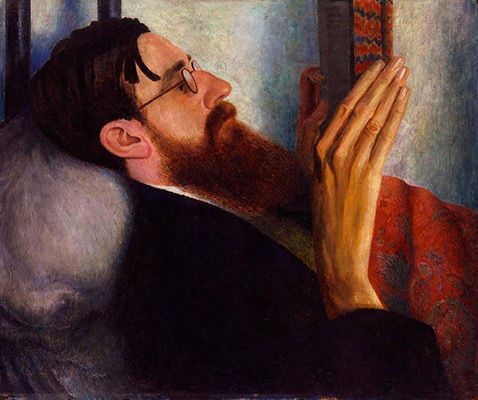
Portrait of Lytton Strachey
This intimate portrait of biographer and critic Lytton Strachey reading a book was painted by his lover Dora Carrington. As with Duncan Grant's painting of his lover, John Maynard Keynes, there's an overwhelming warmth and tenderness to the image, which presents Strachey's characteristic bearded profile in a soft, flattering light. Though not a core Bloomsbury artist, Carrington (she preferred to be known by just her family name) regularly exhibited with the group, and was often commissioned to anonymously produce decorative items for Roger Fry's Omega Workshops as well as book covers for the Woolfs' Hogarth Press.
As a Bloomsbury outlier rather than a central member, Carrington also developed her own, singular take on the European artistic styles that were to influence the group's core members. While Vanessa Bell, Duncan Grant, and Roger Fry were swept up by Post-Impressionist ideas and techniques in their entirety around this time, Carrington took a more measured approach. Instead, her paintings combined a Post-Impressionist approach to light and brushwork, a sense of emotional weight influenced by the Pre-Raphaelites and a palette reminiscent of early Renaissance art, creating less overtly modern - though still fresh - work firmly rooted in painterly traditions.
Oil on panel - The National Portrait Gallery, London
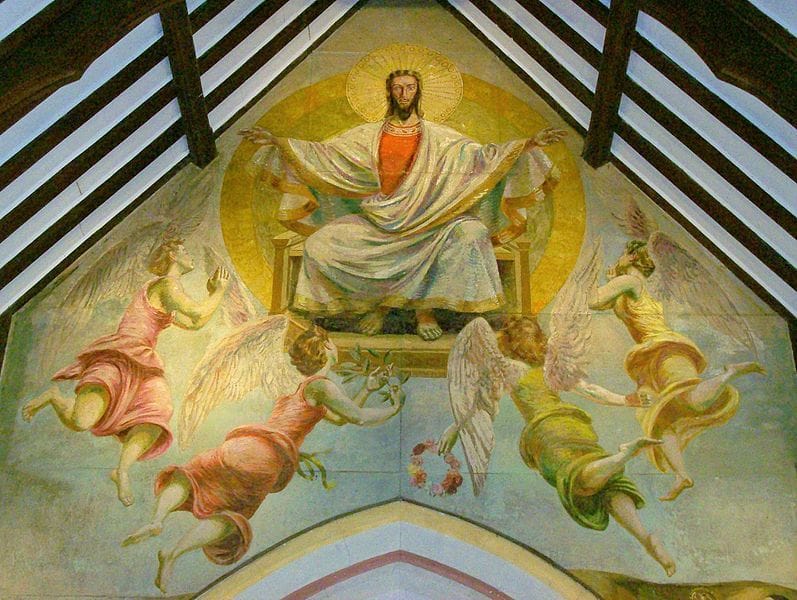
Berwick Church Murals
The Berwick Church Murals were a collaborative, cross-generational Bloomsbury endeavor. The series features a very Bloomsbury-style take on traditional Christian imagery, including the Annunciation, the Nativity, the wise and foolish virgins, and Christ in glory. Duncan Grant was initially commissioned in 1940 to paint the decorations for the small church in Sussex, England, and he invited his long-term collaborator, friend, and erstwhile lover, Vanessa Bell to join him on the project, along with her children, Angelica and Quentin. The artists all posed for each other in biblical dress as well as engaging local farmhands as additional models.
The scheme met with disapproval from a group of churchgoers, who objected to the modernity of the designs. The murals went ahead despite their objections after a two year delay, though Grant was made to render his version of Christ so it was less 'fleshy' and more classically divine in appearance. Once the panels were installed, however, they were broadly praised, with Sir Charles Reilly (the project's founder), describing them as "like stepping out of a foggy England into Italy."
Beginnings of The Bloomsbury Artists
Gordon Square
When upper-middle-class man of letters, Leslie Stephen, died in 1904, his daughters Vanessa (later Bell) and Virginia (later Woolf) - an aspiring painter and novelist respectively - decided to move out of their family home. With a strong desire to leave behind their uptight Victorian upbringing and live a freer, more 'Bohemian' lifestyle, they and their two brothers, Thoby and Adrian, set up residence at 46 Gordon Square in Bloomsbury, then regarded as a rather downscale area of London.
Thoby Stephen regularly brought his intellectual and artistic friends from Cambridge University to Gordon Square, including Roger Fry, Clive Bell, and Duncan Grant. This wider circle of 'Bloomsberries', as they jokingly started to refer to themselves, was a heady mix of artists, novelists, economists, and intellectuals, and would also come to comprise such luminaries as economist Maynard Keynes, painter Dora Carrington, novelist E.M Forster, and critic Lytton Strachey. Many of these talented young people (including Grant and Fry) were members of the intellectually elite society known as The Apostles, made up of selected students from King's and Trinity Colleges at Cambridge University.
The Bloomsberries
The Bloomsbury Group drew much of its strength from this remarkable disciplinary diversity. All its members were known for radical thinking in their respective subject areas, as well as an exceptional wit and articulacy in conveying them. Virginia Woolf is now globally acknowledged as a pioneer of modernist and feminist literature - the 'stream of consciousness' technique she employed in her novels, for example, was truly groundbreaking and is still startlingly original, even a century later. Another core Bloomsberry, the economist John Maynard Keynes, forged some of the most influential (and controversial) monetary and economic theories of the 20th century. Unexpectedly for an economist, Keynes was well known for his sharp wit, literary bent, and remarkably adventurous sex life, even by Bloomsbury standards.
Other well known members or close associates included trailblazing novelist E.M Forster, famous for his sympathetic portrayals of characters from across the class and race divide. Analytic philosophers G.E Moore and Bertrand Russell also had a profound impact on the Bloomsbury artists - they especially appreciated Moore's emphasis on aesthetic enjoyment and friendship as the most essential of human values. Aldous Huxley, too, was deeply influenced by his many early encounters with the Bloomsberries at their patron Lady Ottoline Morrell's country house, Garsington Manor. These meetings are widely credited with helping the author of Brave New World develop his exceptionally honed literary mind and conversational skill, qualities that would make his later novels so exceptional.
Living in squares, painting in circles, loving in triangles
Over the years, the Bloomsbury Group became equally famous for their permissive attitudes to sex and relationships - especially by the conservative standards of their era - as they were for their art and literature. In the British national imagination particularly, they have become synonymous with sexual freedom and open relationships, with exhibitions about them often providing diagrams to enable viewers to make sense of their tangled love lives. The American writer and friend of the group, Dorothy Parker, famously quipped that they "...lived in squares, painted in circles and loved in triangles."
Clive Bell, for example, fell in love with Virginia Woolf soon after the birth of his and his wife Vanessa's first child. Vanessa herself had a relationship with Roger Fry, as well as a longstanding and open affair with the otherwise mostly homosexual Duncan Grant that resulted in a child, Angelica, who would eventually marry her father's long term lover, David Garnett. The critic Lytton Strachey had numerous affairs with men while in his long relationship with Dora Carrington, who herself married one of his lovers, reportedly to keep Strachey close to her.
The Friday Club & The Grafton Group
Formed in 1905 by Vanessa Bell and a group of her friends from London's Royal Academy of Arts, the Friday Club became a regular focal point for the Bloomsbury artists. Bell had been inspired by her experiences of the stimulating buzz of Parisian café life, with its exhilarating artistic conversations and flow of ideas, and wanted to bring a similar atmosphere to artistic meetings at Gordon Square. The Friday Club's primary focus - spearheaded by Clive Bell - was to provide exhibiting opportunities for its participating artists at small London galleries such as the Alpine Club and the Bailey Gallery. This was in addition to coordinated lectures and discussions about art and developments in the European art world and beyond. The roster of attendees between 1905 - 1913 reads like a Who's Who of the British avant-garde of the time. As well as all the key Bloomsbury artists and art critics, it also included such important British artists as Henry Lamb, John and Paul Nash, and Edward Wadsworth.
From 1913, the Bloomsberries and many of their associates shifted from the Friday Club to a new exhibiting society founded by Roger Fry, the Grafton Group. This club focused on UK artists working in the Post-Impressionist style - though they also showed American Cubist Max Weber and Russian pioneer of abstraction Wassily Kandinsky as part of their extensive program.
The Post-Impressionist exhibition of 1910
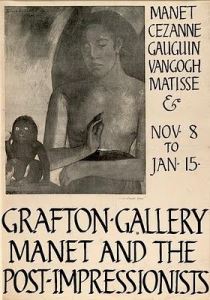
Since encountering the work of Paul Cézanne during a trip to France in 1906, Roger Fry had become an ardent admirer of the modern French painters of his day. He was especially excited by the way artists such as Cézanne and Manet were using paint to explore emotions and increasingly rejecting the signature naturalism of their predecessors, the Impressionists. In 1910, Fry organized an exhibition of these works at London's Grafton Galleries, including mainly French artists including Seurat, Manet, Cézanne and Van Gogh. In fact, he was the first to coin the term 'Post-Impressionism' to describe what he saw as this new and vital artistic style that prized form over content.
While Fry was convinced that bringing these 100 or so works to a UK audience would breathe fresh life into British artistic and cultural life, the country's public and critics had other ideas. The show was almost universally panned, with words such as "anarchy", "putrescence", "sickness of the soul" and "pornography" among the accusatory terms used to describe it. It ruined Fry's reputation as a cultural force among his contemporaries, but ultimately fixed his place in history - Post-Impressionism would prove to be one of the 20th century's most pivotal movements, emerging as a vital influence on Cubism, Art Nouveau, and the German Expressionists.
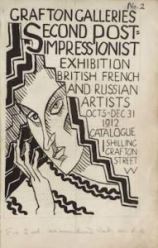
A second Post-Impressionist exhibition closely followed in 1912. This time, Fry included works by Bloomsbury artists and their associates including Grant, Bell, Wyndham Lewis, and himself as well as pieces by Braque, Picasso, Cézanne, and Matisse and others. Although the British artists in Fry's show were ultimately less esteemed than their European counterparts, the exhibition linked them to each other and cemented the Bloomsbury artists' (especially Vanessa Bell and Duncan Grant's) place in the artistic canon.
Charleston House
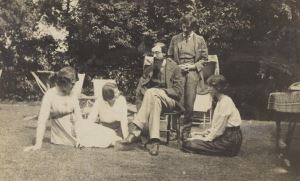
While the Bloomsbury artists all regularly vacationed together, to France, Italy, and Greece, they routinely congregated at the home of Vanessa Bell, the group's longstanding artistic linchpin. As well as the original house in Gordon Square, Bell rented Charleston House in Firle, Sussex, as a country retreat in 1916. She and her lover Duncan Grant (and occasionally Clive Bell) would spend extended periods of time at the property, which they filled with rich decorations on doors, walls, fireplaces, and furniture. The house was converted into a Bloomsbury Museum in the 1980s and remains a vivid, living testament to the Bloomsberries' extraordinary visual abilities and entwined histories. The studio where Vanessa and Duncan for years painted side by side, for example, is faithfully reconstructed.
Cultural Elitism
The Bloomsbury artists had an undeniable tendency to intense snobbery and cultural elitism, qualities for which they've been roundly derided. Despite their stated desire to break free of the uptight conventions of Victorian England, the group steadfastly held onto incredibly traditional notions of the upper classes vs the uncivilized masses. Clive Bell, for example, wrote a book called Civilisation in 1928, in which he expressed disdain for "the barbarian" in his "suburban slum", hoping that such people would take note of the "civilizing elite" and their superior cultural pleasures, rather than continuing to involve himself in such abhorrent activities as "football and cinema."
Bell also completely discounted the relevance of ordinary citizens' emotional responses to artworks. He unapologetically stated that genuine art was not concerned with "what the grocer thinks he sees" but was designed to be appreciated only by "educated persons of extraordinary sensibility."
The Bloomsbury Artists: Concepts, Styles, and Trends
Portraiture
Unsurprisingly for a group that was so forcefully driven by such strong personalities who lived, worked, and loved so closely for so long, the Bloomsbury artists produced a large number of portraits and self-portraits throughout their artistic careers. Their favorite subjects were each other, their relatives, and their intellectual associates, especially the Bloomsbury writers - most of the well known painted portraits of Virginia Woolf, for example, were produced by either Vanessa Bell or Duncan Grant throughout their earlier conservative, mid Post-Impressionist and later Naturalist phases.
Close Bloomsbury associate, Dora Carrington, is renowned for the numerous, highly intimate portraits she created of her lover, group stalwart Lytton Strachey, in her distinctive part post-impressionist/part post-Raphaelite style. Duncan Grant, meanwhile, painted unabashedly erotic young male nudes, which are now considered fundamental works of Queer art, as well as secretly making many erotic photographs of himself and his lovers of both genders. Grant reportedly realized Bell was in love with him when he caught her staring at him in his shaving mirror - a scene which she later immortalized on canvas.
Experiments in Abstraction
The Bloomsbury Group were among the first British artists to engage with pure abstraction. Core Bloomsbury artists Vanessa Bell, Duncan Grant, and Roger Fry were especially experimental between about 1908 - 1914, pioneering techniques such as collage, as well as groundbreaking ideas around color and form that were heavily inspired by the Post Impressionists they so admired. Bell's abstract works from this period, such as her Abstract Painting (1914), in which she boldly translated everyday objects into sophisticated abstract forms, are now considered particularly important. The impact of these experiments on the direction of British art as a whole was enormous too, directly inspiring artists such as Paul Nash and Wyndham Lewis, who would go on to become highly significant 20th-century artistic figures.
The Hogarth Press
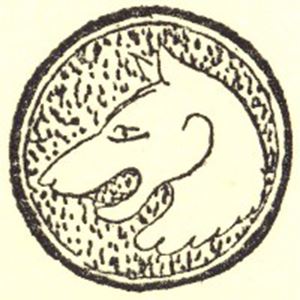
Founded by Virginia and Leonard Woolf in 1917, the Hogarth Press gave rise to some of the most famous collaborations between Bloomsbury writers and artists. The Press's first project was a book of stories written by Virginia and Leonard and illustrated by Dora Carrington, printed on a simple hand press on the Woolf's kitchen table. By the 1920s, the endeavor had moved to larger premises on Tavistock Square in Bloomsbury, and was publishing works by other key writers of the age, including the first translations of Russian greats Chekhov, Tolstoy, and Dostoevsky; the first edition of The Wasteland by T S Eliot and works by Sigmund Freud, in addition to many important novels by Virginia Woolf herself.
Vanessa Bell designed distinctive and strikingly unconventional covers and book jackets for the majority of the press's literary output. She also brought in artists such as Graham Sutherland and William Nicholson, and these book designs combined with the groundbreaking literature they were illustrating to lend a bold, unmistakably modernist feel to the Hogarth Press's seminal publications.
Omega Workshops
Established by Roger Fry in 1913, with Vanessa Bell and Duncan Grant as co-directors, the Omega Workshops represented a radical effort to blur the boundaries between avant garde (especially Post-Impressionist) art and design. Unlike the overlapping Arts and Crafts Movement, which was driven by a strident political and social ethos, Fry was simply concerned with erasing what he saw as the false split between art and the decorative arts. He also wanted to help his artist friends make a decent living by putting their artistic talents to broader use. The Workshops produced a vast range of furniture, textiles, and household items such as candlesticks and cushion covers, all stamped only with Ω - the Greek Omega symbol to ensure that all products were appreciated purely for their aesthetic appeal rather than the reputation of the artist that designed them.
Despite its long-term impact, the Omega Workshops lasted only six years. Fry was forced to cease operations in 1919, due to a combination of dwindling orders, inefficient techniques, and expensive materials. Internal arguments also played a large role in the enterprise's downfall. In 1913, four Omega artists - including future Vorticists Wyndham Lewis and Frederick Etchells - quit the workshops after a dramatic and very public falling out over Omega's contribution to London's Ideal Home Exhibition. They released a slanderous letter to patrons and shareholders, accusing Fry of nefarious dealings and mocking Omega's ideals and products. Having ploughed huge amounts of his own money into the workshops, Fry was particularly bitter at its enforced closure, writing to a friend at the time: "I can't waste more (money) on a country that regards the attempt to create as a kind of Bolshevism."
Art Theory and Criticism
Unsurprisingly for a group that was so inspired by the regular exchange of artistic ideas through conversation, the Bloomsberries included important art critics, theorists, and art historians as well as novelists and artists.
The most prominent were Roger Fry and Clive Bell, with Fry's extensive writings in particular generally acknowledged to have stood the test of time. He helped found Britain's first art history periodical, Burlington Magazine, in 1903, co-edited it between 1909 - 1919, and would write regular essays on diverse subjects for the title until his death in 1934. Burlington remains the longest running art history journal published in English and one of the UK's most influential.
Fry also penned books on Cézanne, Matisse, Flemish painting, and psychoanalysis and art, among many other topics, though his most important contribution to the theoretical canon is widely agreed to be his book Vision and Design (1920). As well as European and American art, Fry looked closely at the use and effects of form in non-Western practices - from Asia, the Americas, and parts of Africa - a groundbreaking approach that was especially radical to Western readers in the early-20th century. The book also contained the seminal piece, An Essay In Aesthetics, which is an examination of aesthetic perception that meticulously described how artworks affect viewers physically and emotionally. Vision and Design is now considered a key text in the development of modernist art theory.
Clive Bell's aesthetic theories achieved reasonable prominence in his day, though they proved less crucial to the formation of modernist ideas than Fry's. His most influential theory, what he called 'significant form', prized an artwork's formal qualities far above its subject matter. He claimed that skillfully rendered line and color were the most important elements in any work of art, and was especially dismissive of public appreciation for Realism, with what he saw as its preoccupation with narrative and political ideals. Bell saw Paul Cézanne as the purest employer of significant form, but the theory also gained currency with his fellow Bloomsberries in the years before World War I, especially in the work of Vanessa Bell and Duncan Grant.
Though she never considered herself an art critic in the same sense as Fry or Bell, Virginia Woolf's essays and novels were hugely inspired by Bloomsbury's artist members and their enthusiasm for Post-Impressionism. Her seminal essay on the history of the novel, Mr Bennett and Mrs Brown (1924), identified 1910 - the year of Roger Fry's groundbreaking First Post-Impressionist exhibition in London - as a crucial turning point in the evolution of both literature and art. It's now widely accepted that the Post-Impressionist revolution in the visual arts sparked Woolf's realization that a similar sea change was possible in the literary world, thus paving the way for some of the most important novels of the modernist era.
Virginia Woolf and her sister, Vanessa Bell, also played fundamental roles in the development of each other's work and ideas. In 1930, Woolf wrote the catalogue essay for Bell's exhibition at a gallery in Mayfair, London. She opened the piece with the line "That a woman should hold a show of pictures in Bond Street...is not usual', and went on to challenge the limits imposed on creative women of the time by a conservative society that expected them to be subservient and domesticated. She was especially struck by London art schools banning female students from the life modelling room 'on moral grounds' - mentioning the issue in her catalogue essay served to emphasize her sister's radicalism in painting so many nude subjects. Bell's experimental methods of representing individuals through portraiture also helped push Woolf to reimagine new ways to represent individuals in her novels, a feat she achieved in pioneering works such as To The Lighthouse (1927) and The Waves (1931).
Later Developments - After The Bloomsbury Artists
The end of the 1930s brought about huge changes for the Bloomsbury Group. While younger members, such as Angelica and Quentin Bell, continued to create artworks under the Bloomsbury moniker, the set known as 'old Bloomsbury' was running out of steam, with a series of deaths acting as catalysts for the group's dispersal. Lytton Strachey passed away in 1931, soon followed by the suicide of his distraught lover, Dora Carrington. Key critic and artist Roger Fry died in 1934, while the Bells were intensely affected by the death of their son, Julian, in 1937 as well as Virginia Woolf's suicide by drowning in 1941.
It's widely acknowledged that the remaining Bloomsbury artists' work became far less innovative after World War I. Younger, more socially attuned modernists such as Barbara Hepworth, Henry Moore, and Paul Nash started to overshadow them as the vital artistic commentators of the day. The Cunard Affair of 1936, in which Duncan Grant and Vanessa Bell created a series of paintings for a luxury cruise liner only to have them very publicly rejected by the company's chairman, also inflicted irreparable damage to the group's reputation.
Opinion on the Bloomsbury artists' legacy is exceptionally mixed. Some commentators deride them as overrated and are generally contemptuous of their current status as a mainstream brand - their lives have been dramatized in several television mini-series, and the subjects of huge numbers of biographies and memoirs. The contemporary art critic Waldemar Januszczak wrote that even the act of typing the word Bloomsbury gave him "a severe attack of RSI [Repetitive Strain Injury]."
However, the group is also acknowledged as crucial to the development of 20th-century British visual culture. Their efforts to back young artists through the formation of supportive clubs and societies were direct precursors to British organizations with the same remit today, such as London's Contemporary Art Society. These societies were early champions of the key Surrealist and war artist Paul Nash, pioneering British abstractionists Victor Pasmore and Rodrigo Moynihan, as well as other members of their politically progressive Realists of the Euston School that emerged in the 1930s. Of all the Bloomsbury artists, it's Duncan Grant and Vanessa Bell who left the greatest artistic legacies. London's Dulwich Picture Gallery, for example, held Bell's first major retrospective in 2017, presenting her as a pivotal figure in modern British art.
Museums and Sites of the Bloomberries
Vanessa Bell's country home and location of many a Bloomsbury meeting, Charleston House in Sussex, was converted into a museum dedicated to the group in 1986. Bell's decorative interiors, paintings by Bell and other Bloomsberries, her garden, furniture, and household objects (including many produced by the Omega Workshops) have all been carefully restored and preserved. In keeping with the spirit of its historical occupants, the museum regularly hosts innovative literary, learning, and artistic events that aim to embody Bloomsbury values in a contemporary setting. Virginia and Leonard Woolf's Sussex home and additional gathering place for Bloomsbury luminaries, Monk's House, has been restored to feel 'as if the Woolfs had just stepped out for a walk', and is also open to the public. In addition, fans can see multiple plaques in Gordon and Fitzroy Squares in Bloomsbury that highlight locations of the group's main London bases, as well as the Omega Workshops headquarters.
Useful Resources on The Bloomsbury Artists
- The Bloomsbury Group (2014)Our PickBy Frances Spalding / A collection of biographies and paintings of Bloomsbury artists by the National Portrait Gallery
- Vanessa Bell: Portrait of the Bloomsbury Artist (2016)By Frances Spalding / A biography of Vanessa Bell -- one of the main Bloomsbury artists
- Bloomsbury: Its Artists, Authors, and Designers (1990)Our PickBy Gillian Naylor / Index of Bloomsbury visual works, writings and designs by members of the cultural group
- A Room of Their Own: The Bloomsbury Artists in American Collections (2008)Our PickBy Nancy E. Green and Christopher Reed / The accompanying catalogue to the 2008 exhibition of the same name, which focused on the work and social context of the Bloomsbury artists
- The Bloomsbury Artists: Prints and Book Design (2000)By Tony Bradshaw, James Beechey, and Angelica Garnett / Catalogue of print work by some of the core Bloomsbury artists
 Ask The Art Story AI
Ask The Art Story AI